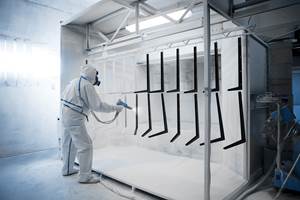Racking Without Visible Rack Marks
What is the process of racking a machined part to be anodized with no visible rack marks?
Q. What is the process of racking a machined part to be anodized with no visible rack marks? We have a round part with no holes, grooves or recesses. I believe that tumbling or basket anodizing will not work because the conductivity would be lost once the anodic coating is formed. What method of racking would you suggest?—M.J.
A. The part you are describing sounds like a solid cylinder (long and slender, or perhaps wide and flat) with no holes or grooves to help with racking. It also sounds like the entire surface of the part is exposed and, therefore, explains your desire to anodize without a rack mark. You don’t say if the parts are dyed after anodizing so I will assume that the parts are clear anodized. Nor do you say what type of anodizing is required. Is it Type II or Type III, for example?
Sometimes it is possible to anodize parts without a visible rack mark on the exposed surface. One simply attaches the part to the rack in areas that are not visible on the finished product. Parts that must be racked on exposed surfaces will almost always have some sort of visible rack mark. It’s a matter then of how visible the rack mark is, or looking at it from another viewpoint, how difficult it is to find the rack mark. It sounds like the part you are talking about may not be able to be anodized without a visible rack mark. The larger the part, the more difficult it will be to hold it on a rack with fingers that grip the part and hold it firmly. Even if the rack mark is small, you might not be able to hold the part firmly enough to keep from losing it during processing. The size and weight of the part will also be a factor in how easy or difficult it is to keep it on the rack.
The type of anodizing process also will determine the size of the rack mark. If a very small part is to receive a relatively thin anodic coating, it may be possible to process it with only a very small rack mark, one that you have to search for to see. If that same part were to require a Type III (hardcoat) anodize, for example, it would most likely have to be held very firmly in order to maintain a good electrical contact during the entire anodizing cycle. This might result in a more visible rack mark. If the parts are to be dyed, especially a dark color, it might be even more difficult to process the parts with no visible mark.
As you can see, there are many variables that come into play in determining the size and visibility of the rack mark. Part size, weight, shape and even the alloy play an important role, as does the type of anodizing process. Obviously, having a variety of rack styles to choose from will also be an important part of the equation for racking parts with as small a visible rack mark as possible. Sometimes a part can be redesigned to make it easier to rack for a very small visible mark. If your part is going to be a long running one, it might be worth a try to see if the part design could be changed enough to make it easier to rack. There are times when the parts in question simply cannot be racked and successfully anodized without a visible mark.
Related Content
Chicago-Based Anodizer Doubles Capacity, Enhancing Technology
Chicago Anodizing Company recently completed a major renovation, increasing its capacity for hardcoat anodizing and Type II anodizing.
Read MoreFilm Thickness Control
Have a powder coating job that requires precise film thickness control? Products Finishing columnist Rodger Talbert offers advice controlling the variables that can impact your success.
Read MoreTroubleshooting 5 Common Racking Problems for Platers
Being aware of usual issues that might occur during the plating process will prepare platers by helping them know how to avoid them all together or how to fix them if they happen.
Read MoreHTE Powder Coatings Take Coverage to the Next Level
High-transfer efficient powder coatings deliver cost, time and energy savings.
Read MoreRead Next
Episode 45: An Interview with Chandler Mancuso, MacDermid Envio Solutions
Chandler Mancuso, technical director with MacDermid Envio discusses updating your wastewater treatment system and implementing materials recycling solutions to increase efficiencies, control costs and reduce environmental impact.
Read MoreEducation Bringing Cleaning to Machining
Debuting new speakers and cleaning technology content during this half-day workshop co-located with IMTS 2024.
Read MoreMasking Solutions for Medical Applications
According to Custom Fabricating and Supplies, a cleanroom is ideal for converting, die cutting, laminating, slitting, packaging and assembly of medical-grade products.
Read More






















